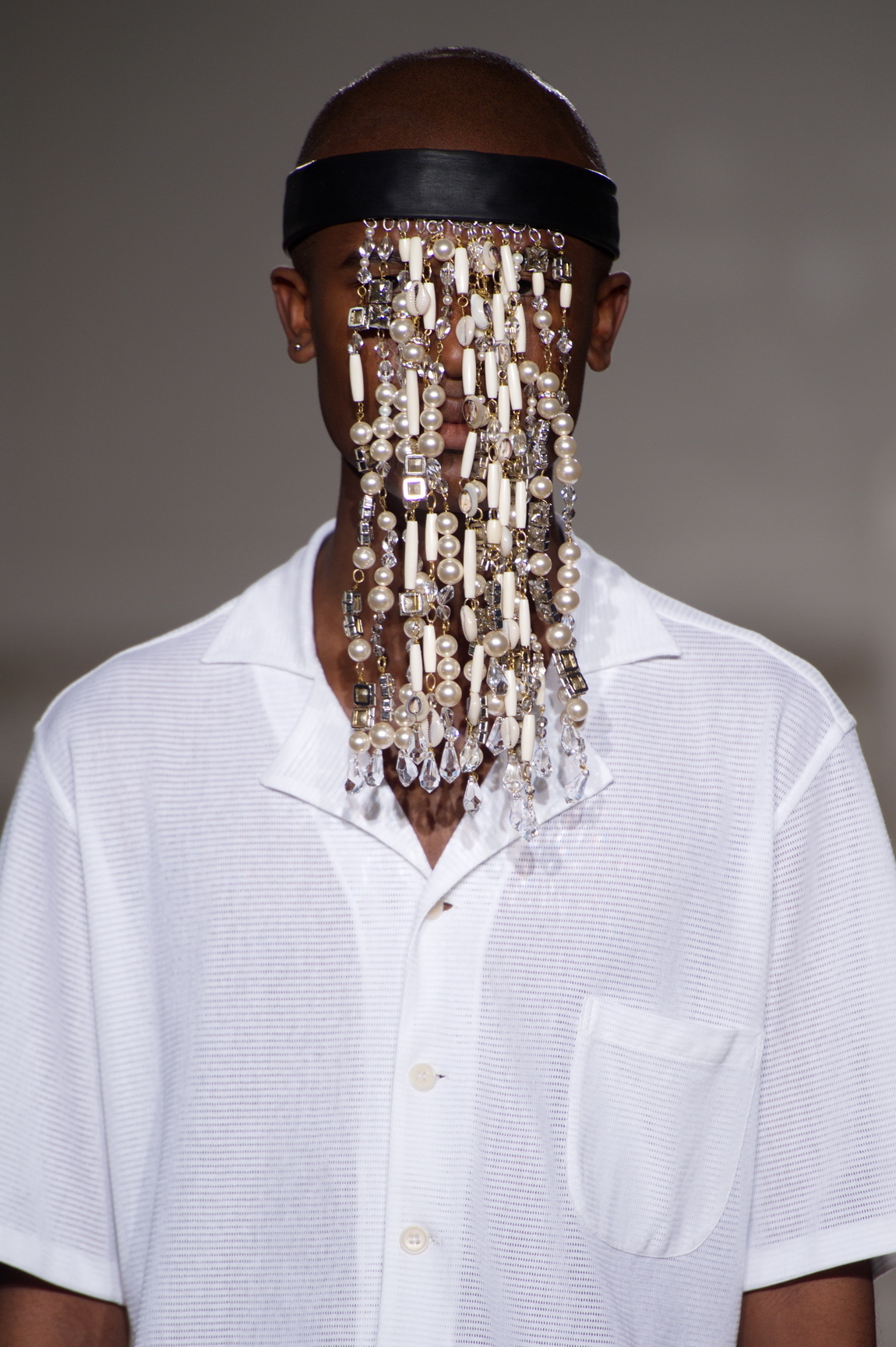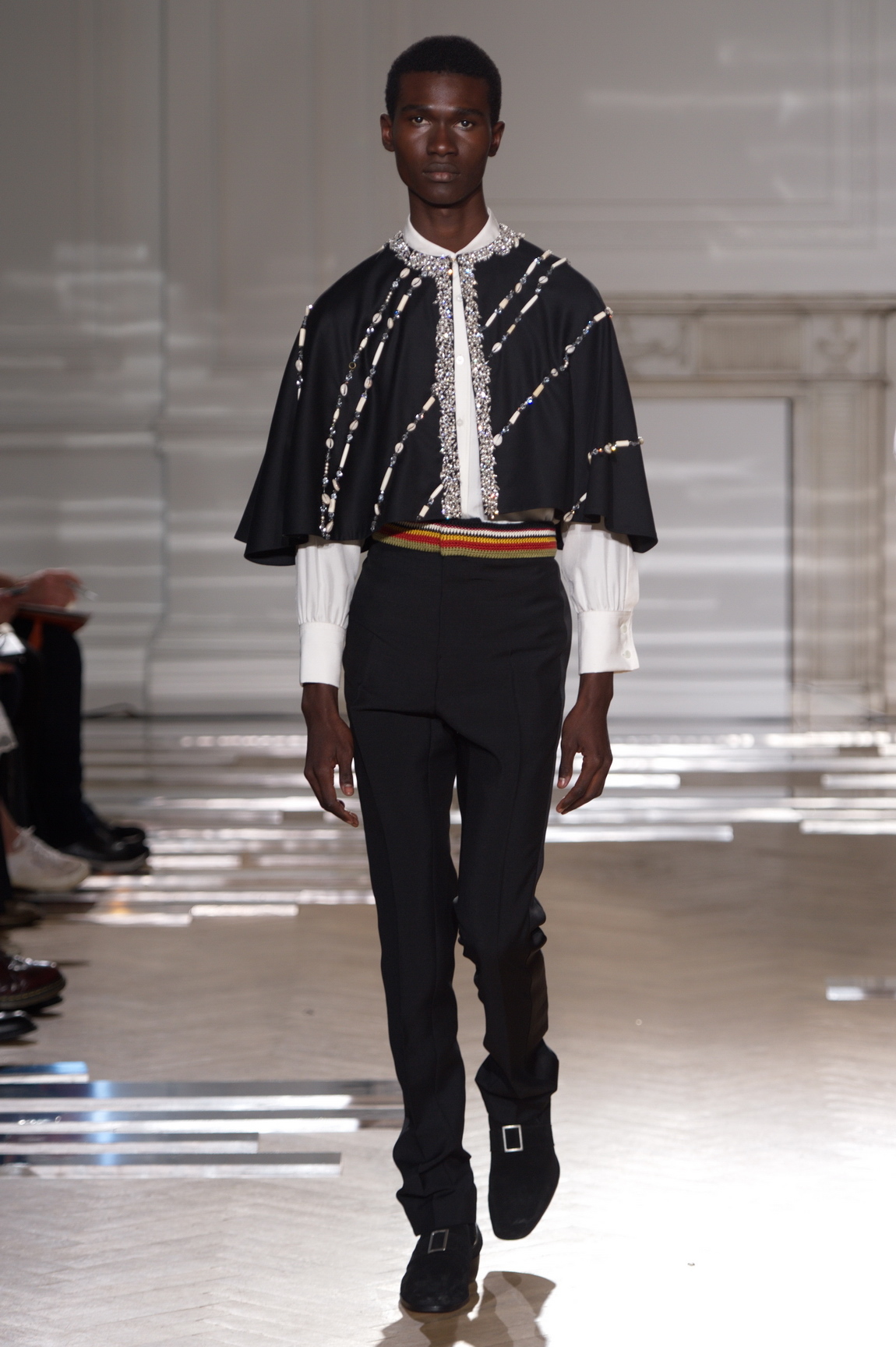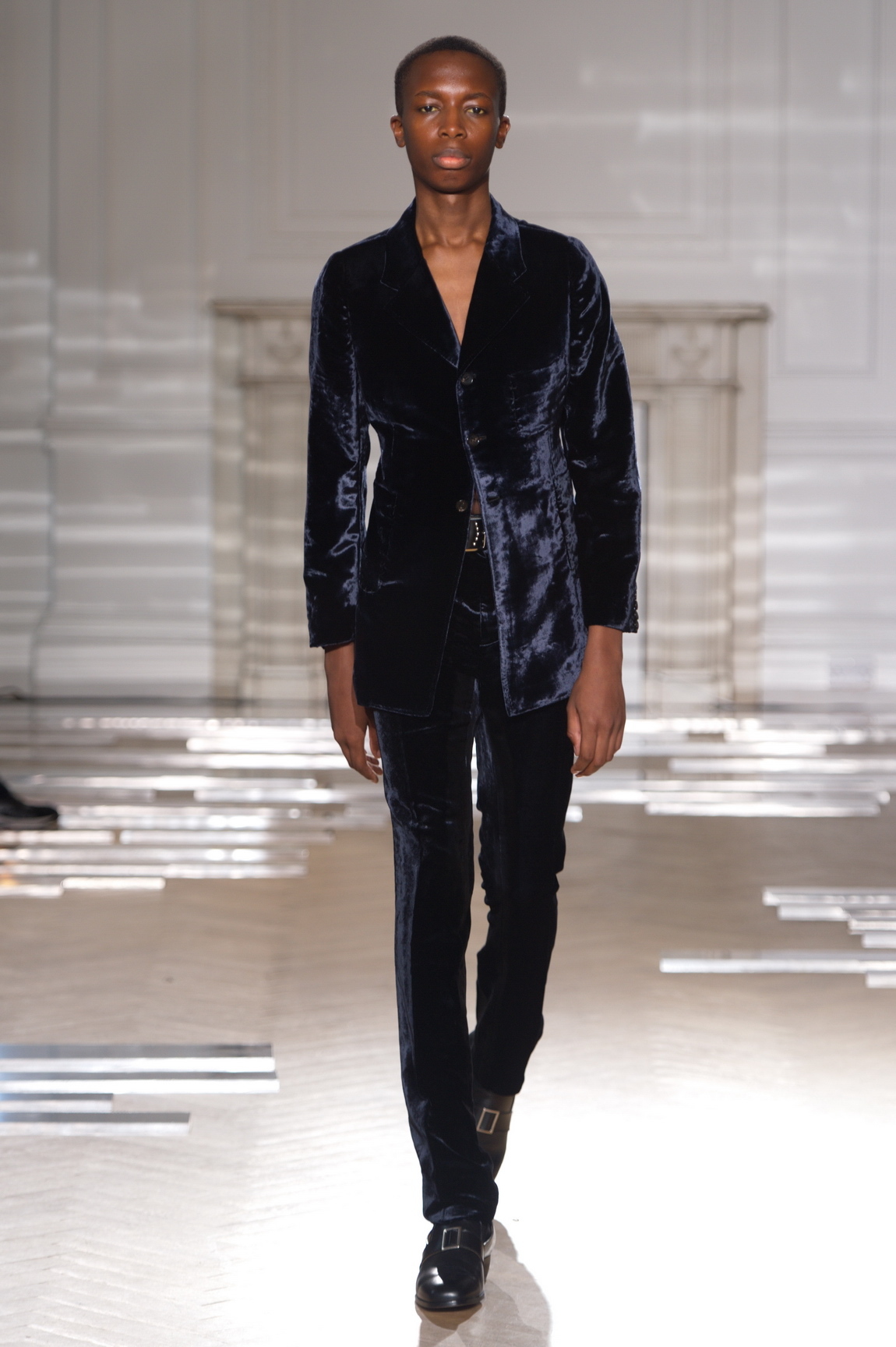Grace Wales Bonner only graduated two years ago. Delivering what was widely acknowledged as one of the strongest collections of this season, her fifth official show won her the LVMH prize and secured her place as one of the young British greats, confirming what we already suspected; Grace is something special. The collection itself was a study on black masculinity, a faux coronation of the Emperor of Ethiopia and a meeting of cultures in what the designer dubbed “pan-African,” whilst taking in Caribbean influences.
The soundtrack came proud and classical, carefully selected by Grace’s friend and now collaborator, the NY-based musician Kelsey Lu. Fans of great music might already know about her, her beautiful voice, and her feature on the freshly-dropped Blood Orange album. Fans of great music who don’t, should get to know.
For the spring/summer 17 Wales Bonner show, the classically-trained Lu turned to the works of boundary-pushing Chevalier de Saint-Georges, one of the earliest recorded classical musicians of African descent and an early supporter of racial equality across England and France. With Lu in London, the two artists spoke in conversation for i-D over lunch. Discussing their collaboration, different aspects of their own identities, and rather topically, how the coming together of cultures is not only incredibly important but also a huge source of inspiration. May the two of them collaborate again and again and again.
GWB: How did you first become of aware of Saint-George’s work?
KL: I think my sister told me about him first, and then when I was also researching black classical composers, he came up and I asked her about him and she played me one of his violin concertos and that sent me on a whirlwind.
Do you and your sister ever work together?
Well when I did those Barclays Center shows with Florence, she played with me, but it was the first time we played together in a long time. When we were little we played in orchestras together and then during college, we started a band called Black Ivy with my friend Casey who plays viola… we would play over drum and bass.
Nice. It’s interesting working with a European framework in terms of classical music and composition because I’ve always been really interested in this idea of black artists that operate within established or institutionalised frameworks. I like how they work within those systems and can be quite subversive or dismantle things by understanding what it is and having a sense of like rhythmicity or coming from a different standpoint, but within that framework. Do you feel that you can see some blackness in the work or do you feel that it’s quite conformist?
I feel like all of it, especially his violin concertos, were so far advanced and his technique was so different from everyone else. He was known for having concertos that are very hard to play because they jump from being really high to going way low. It was pushing boundaries technically, so much so that Mozart stole pieces of his melodies. And I think that the fact that he pushed himself further than everyone else was because of his blackness. Because he had to try and prove something and push himself further than everyone else. So in that respect, that’s where his blackness comes in I think. And then in one of his violin concertos, the second movement is really sad. I was watching a documentary saying that the piece was around the time of this love affair that he had with a woman who got pregnant, and when she had the baby her husband took the baby and put it in a room to die. So the second movement is kind of his mourning of that and I feel like it’s unlike any of the other pieces that he had because you can really hear the sadness in the music and I feel like that was a moment of him feeling a very raw emotion.
Is that the thing that you sent me initially?
Yeah.

It does feel very different. As a character he’s really interesting too and I related him to people like Haile Selassie. I connect with these kinds of historical characters in my mind because they play a certain function and I felt like there was this innate understanding in them that they’d been exposed to and educated in a very specific European kind of school of thought language institution. And then I was connecting and thinking about how in those strict structures you can still express who you are, and maybe that’s super subtle, but with Haile Selassie I noticed how in different situations he’d perform his blackness in different ways; sometimes he’d be wearing European military dress to show how sophisticated Africans can be, and then in some situations he’d want to show that he was different to Europeans and he was African and coming from a different point of view.
It’s interesting how Saint-George was kind of the only black figure in the world that he was living in until the time of the revolution, and then he was the leader of the first all-black brigade which was kind of a big deal. Then he was imprisoned by the revolution and because he was still an aristocrat, he wrote a letter to the leader of the revolution explaining that he was raised in this aristocratic environment and but never really taken on, never accepted, and it was rejected and so he stayed in prison for a little while but was eventually set free. But it’s really interesting how he was constantly fighting for a sense of freedom and just acceptance from all sides.
How do you feel you express your position as a black woman in your own work? Do you feel it comes through?
That’s something that I’ve been trying to figure out recently, because I could easily see myself fit into a category of what a ‘black artist’ is, but I dunno, I am black so I guess just naturally comes through with the things that influence me. What about you?
The thing I think about more is hybridity and merging two points of reference… or how identity is formed by a lot of different strands and is all about that tension, but I guess that relates a lot to my upbringing and who I am. I think my work is about allowing different points of reference from different levels of society to stand together and be respected or appreciated in the same way. So treating your references or your points of inspiration with the same level of attention as though they’re like, something that you found in a market that isn’t an academic source, or a couture technique. But I guess I just asked that because from talking to you, you seem very conscious and aware of who you are and your position and I just wondered how you thought that translated.
I guess it’s just being conscious of things. Knowing certain things about history and the things that make up who we are; discovering those, it’s impossible to create something and for it not to affect your work. When I was working on the show soundtrack I was researching the history of music in Ethiopia and also reading up on some paintings, so I was also doing a lot of research into the history of that diaspora. Through those things I created something based off of that feeling of learning about the makeup of who we are so it’s like; what is the ‘black sound’ and what does that mean? And it’s really what you make it. There’s no guide because in Ethiopia there’s been so many innovators through time of making new sounds and like, creating new genres but that ultimately kind of stemmed from where they come from. In the same way, I grew up around jazz because of my dad but I also grew up with classical music, and I think the combination shaped a lot of my sound.
I think it’s really interesting that you say with the research process you didn’t necessarily intend or need to communicate something; that just by being exposed to certain references it’s like there’s a residual thing that carries through even if you don’t intend it to. I kind of feel the same with images. I guess I join things up in a quite playful way but then actually being exposed to certain images of a certain time and thinking about European influences in the Caribbean or in Ethiopia, there’s this residual thing in images that carries through into the work and people feel it. Which is kind of interesting again with music how there can be a feeling, an emotion that exists without even intending it to just because of the subject matter or anything you know.
What is your heritage?
My dad is Jamaican, my mom’s English, and I grew up in London. I have a big family on my dad’s side and have had a very immersive upbringing in terms of the Caribbean side of my heritage.
Have you ever been to Jamaica?
I’ve been quite a few times. When I was thinking about this collection, because this was the first time it was more directly related to myself, I found that the interesting thing about the Caribbean is that it’s such a melting pot of so many different references. And the finale music that I sent you, it feels almost Celtic; there are so many different references in that, and that’s what I really loved about it. It was so mixed up and there are so many interesting connections; from the Caribbean to Scotland and Ireland and everywhere. I always think about mixing things together. It’s never about a kind of singular viewpoint, it’s just about multiplicity and lots of things happening simultaneously.
I really like things not being linear. I really wanted the show to end with a non-ending, instead just fading away into an other-worldly sound. I feel like I learned a lot about myself while I was doing it; about my process and timing and how it was only three minutes long but so much happens within those three minutes. There’s so much intention in everything.

I think it’s cool the way that you resolved the piece because my understanding of music isn’t as sophisticated as yours. That’s the really joyful and exciting thing about collaborating with someone that you really respect; the moments where you just have to trust someone and let go. I feel that’s the same with a lot of my team, there needs to be this tension and you need to be pushed out of a space that you understand and then it works in the moment that you let go but you’re carried by something that makes sense.
And it was fun for me like, speeding up “Dreams.”
I feel like that could’ve been really difficult. I was worried that it wasn’t an okay thing to ask.
No, I think it’s really fun to disassemble things and manipulate them.
That’s something I find interesting about Kanye’s album actually; how he just didn’t finish that song. I thought it was cool that you were open to that. With your work, once you’ve finished something does it feel quite final or are you always moving on to something else?
I always think about changing them. I never feel like something is really really finished. I mean there’s so much that could be done! I also really like the thought of somebody that I respect or admire taking it and reworking it. I feel like it has parallels with life; things are changing constantly and I don’t want to get stuck on something. At the same time, I really like creating something and recording it and leaving it alone and sometimes there’s like, incorrect notes or a mistake or flaw, but I like that.
I guess with collections, for me, once it’s done, that’s it. I don’t want to go back. I mean, I reflect on it more creatively but not with the clothes in a different way, more like making imagery around it or something. But I think it’s difficult to try to correct something… you just have to show your intention with the next step I guess.
How does it work with timings, do you give yourself time limits for each piece?
Not really. Sometimes I try and quantify what’s worth spending more time on, but I guess it’s kind of just working to the show deadline. Then from that point it’s like okay, the end of that certain creative process is over but then you have the freedom to like, change the way you represent it through imagery, or extend that conversation. But time’s interesting because I feel like you need to have the pressure of a deadline or there’s a certain amount of energy you can invest in something. I like the excitement and the energy that comes towards the end of a process, but now that I’m trying to work more in advance, it’s a case of trying to sustain that energy, or maybe there’s only a certain amount of energy that you can actually put into something with that level of intensity and excitement?
When I look at your collection, what I love about it is that I could see myself wearing a lot of it, and while it’s obviously supposed to be menswear, there’s a level of androgyny as well. Was that intentional or did it just happen that way?
I guess it’s like, the way that I think about gender, sexuality, and race is quite fluid and so that naturally manifests it. It’s an open thing and it’s really nice that people notice that. Again, I think it’s like your intentions or the things that you’re exposed to, you don’t even need to explain that, it’s just communicated. That’s what I find really amazing about fashion; people read and understand things a lot more than you’d expect. It’s nice to give whoever’s viewing it, not the benefit of the doubt, but you don’t need to simplify your ideas, you can be complex and people will understand it and enjoy it. It’s really cool when a lot of people get it.
I feel like I’ve been experiencing that through my work recently, which is really great because there was a point in time where I felt otherwise. I felt afraid that people wouldn’t understand and that I would in turn be pressured to conform to some other standard or something other than what I naturally do. Now I feel like I don’t have to do that because there are people that are connecting and understanding what I’m doing. It’s really exciting.
Kelsey Lu will appear with Blood Orange at Koko on July 5 before headlining The Waiting Room on July 11.
Credits
Text Francesca Dunn
Photography Mitchell Sams
